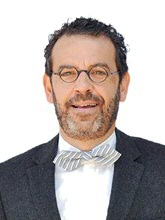Inaugural lecture Professor Lautaro Roig Lanzillotta, Chair of New Testament and Early Christianity

On Tuesday 9 April, Lautaro Roig Lanzillotta will deliver his inaugural lecture as Professor of New Testament and Early Christianity at the Faculty of Theology and Religious Studies of the University of Groningen. The title of his lecture is ‘The Ideal of the Real: Plato’s Myths, Gnosticism and the Historical Jesus’.
New Chair
Lanzillotta was appointed Professor of New Testament and Early Christianity on 1 September 2018. The new chair covers the study of the New Testament and Early Christian world, including the world-famous Gnostic Nag Hammadi texts and the fascinating Apocryphal Christian literature – in other words, the texts which did not make it into the Bible. The chair also covers the study of other alternative forms of Christianity during the religion’s early centuries.
Inaugural lecture on the notion of myth
The focus of Lautaro Roig Lanzillotta’s research has always been Religion and Culture. How is religion embedded in its cultural context? What contacts, interaction and mutual influences are there? Why is it important to understand this interaction? In this sense, his field of expertise is on the intersection of the Greco-Roman and Christian worlds. He is interested in the role that Greek philosophy played in the formation of Christianity and, more specifically, how diverse Greek philosophical currents can help us to explain early Christian diversity.
In his inaugural lecture, Lanzillotta will focus on the notion of myth, starting from the French anthropologist Claude Lévi-Strauss, who affirmed that myth is a form of communication. Indeed, the Greek word mythos originally meant ‘speech’ or ‘word’. For Lévi-Strauss, human beings are language: ‘whoever says Man, says Language, and whoever says Language, says Society’. Like all animals, humans are part of nature. However, they are also different from the rest of nature, since they create the ideal world in which they live by means of language. The clash between culture and nature is central to Lévi-Strauss’s work in general and to his explanation of myth in particular. In fact, in his view, it is this clash between the ideal and the real – the opposition between reality and how we understand it – which produces myth. In traditional societies, myths serve to fill the gap between the ideal and the real world. By playfully combining elements from both worlds, myths do not take away the contradictions, but they make them bearable.
Do ‘artificial myths’ serve to bridge the gap between the ideal and the real?
Lanzillotta explains the subject for his lecture on ‘The Ideal of the Real: Plato’s Myths, Gnosticism and the Historical Jesus’, and why he chose it: ‘ever since my first contact with the structural approach to myth, I was intrigued by the question of whether this view, developed by Lévi-Strauss for the interpretation of traditional myths, can also be applied to artificial myths. Artificial myths are narratives created to enable philosophical and religious texts to explain our world and to bring certainty about issues which escape logical analysis. I am referring to Plato’s mythological creations, Plutarch of Chaeronea’s myths of the afterlife, Gnostic myths about the origin of the world and human beings, and the narratives created by the early Christian communities to make sense of the dramatic events related to the crucifixion and death of Jesus. Whereas traditional myths are created by countless generations and represent the views of traditional communities through the ages, artificial myths are individual creations meant to solve specific problems and to address specific situations.
Do these personal creations have the same objective as traditional myths: namely, to bridge the gap between the ideal and the real? If we are to believe Lévi-Strauss, are they meant to justify the shortcomings of reality in the same way that traditional myths do? More importantly, can we handle these myths in the same way as traditional myths?’
Curriculum vitae
Professor Lautaro Roig Lanzillotta first studied Classics at the Complutense University of Madrid, where he also obtained his first PhD, in Ancient Greek philosophy, in 1997 with a thesis on ‘Envy in Ancient Greek Thought. From the Archaic Period to Hellenism’. In 1998, he received a scholarship from the Rudolf Agricola Institute to come to Groningen to study an Early Christian text, The Apocryphal Acts of Andrew. At that time, he did not know that this would form the backbone of his second PhD, this time in Theology, at the Faculty of Theology and Religious Studies, Groningen. In 2004, he defended his thesis entitled ‘The Apocryphal Acts of Andrew. A New Approach to the Character, Thought and Meaning of the Primitive Text’. In 2003, Lanzillotta was appointed Assistant Professor in the Faculty of Arts of the University of Córdoba, where he taught from 2004 to 2007. In 2006, he successfully applied for the vacant position of Assistant Professor of New Testament in Groningen. He subsequently joined the Faculty of Theology and Religious Studies in 2007. In 2016, he was appointed Associate Professor and from 1 September 2018 he has been appointed Professor of New Testament and Early Christianity in this Faculty.
Inaugural lecture
On Tuesday 9 April, Lautaro Roig Lanzillotta will formally accept this position by way of his inaugural lecture, titled ‘The Ideal of the Real: Plato’s Myths, Gnosticism and the Historical Jesus’.
- When: Tuesday 9 April 2019
- Start: 4.15 p.m.
- Where: Academy building
